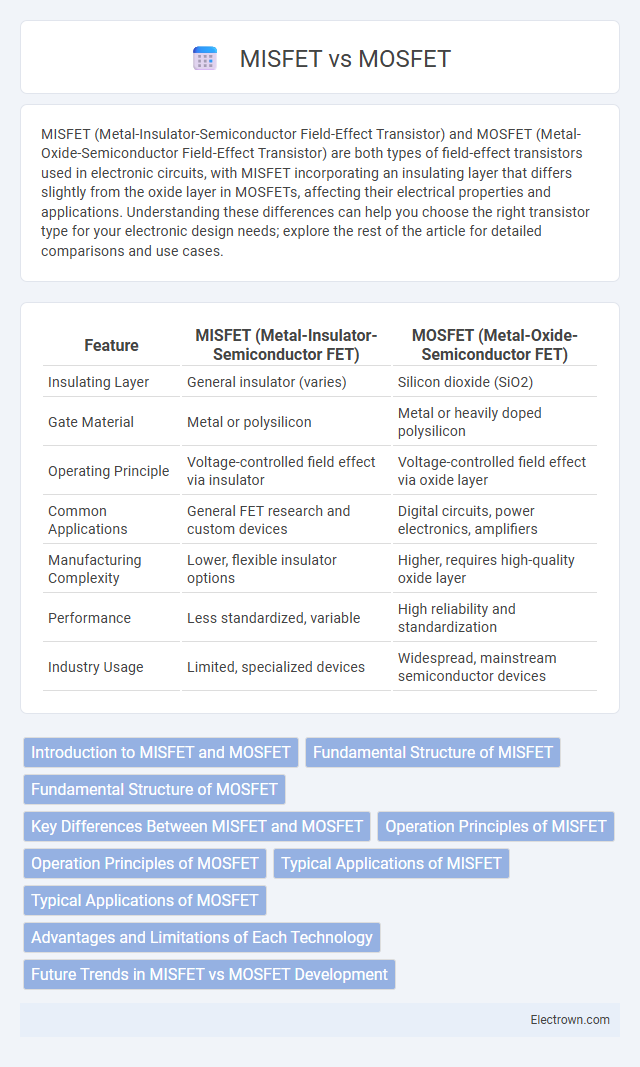MISFET (Metal-Insulator-Semiconductor Field-Effect Transistor) and MOSFET (Metal-Oxide-Semiconductor Field-Effect Transistor) are both types of field-effect transistors used in electronic circuits, with MISFET incorporating an insulating layer that differs slightly from the oxide layer in MOSFETs, affecting their electrical properties and applications. Understanding these differences can help you choose the right transistor type for your electronic design needs; explore the rest of the article for detailed comparisons and use cases.
Table of Comparison
| Feature | MISFET (Metal-Insulator-Semiconductor FET) | MOSFET (Metal-Oxide-Semiconductor FET) |
|---|---|---|
| Insulating Layer | General insulator (varies) | Silicon dioxide (SiO2) |
| Gate Material | Metal or polysilicon | Metal or heavily doped polysilicon |
| Operating Principle | Voltage-controlled field effect via insulator | Voltage-controlled field effect via oxide layer |
| Common Applications | General FET research and custom devices | Digital circuits, power electronics, amplifiers |
| Manufacturing Complexity | Lower, flexible insulator options | Higher, requires high-quality oxide layer |
| Performance | Less standardized, variable | High reliability and standardization |
| Industry Usage | Limited, specialized devices | Widespread, mainstream semiconductor devices |
Introduction to MISFET and MOSFET
MISFET (Metal-Insulator-Semiconductor Field-Effect Transistor) and MOSFET (Metal-Oxide-Semiconductor Field-Effect Transistor) are both field-effect transistors used to amplify or switch electronic signals. The key difference lies in the gate insulator material: MISFET uses a general insulator, while MOSFET specifically uses a silicon dioxide (SiO2) oxide layer, offering improved electrical characteristics and reliability. MOSFETs dominate modern electronics due to their high input impedance, fast switching speeds, and scalability in integrated circuits.
Fundamental Structure of MISFET
The fundamental structure of a MISFET (Metal-Insulator-Semiconductor Field-Effect Transistor) consists of a metal gate, an insulating oxide layer, and a semiconductor substrate, which creates a capacitor-like configuration controlling the channel conductivity. This insulator layer distinguishes the MISFET from a MOSFET by enhancing gate control and reducing leakage current. The ability of the dielectric layer to modulate the surface potential leads to improved device stability and switching efficiency compared to other FET variants.
Fundamental Structure of MOSFET
The fundamental structure of a MOSFET includes a metal gate, oxide layer, and semiconductor substrate, forming a capacitor-like setup to control current flow between the source and drain terminals. A MISFET differs by replacing the metal gate with a metal-insulator-semiconductor junction, enhancing gate control and reducing leakage currents. This structural modification in MISFETs improves device performance in high-frequency and low-power applications compared to traditional MOSFETs.
Key Differences Between MISFET and MOSFET
MISFET (Metal-Insulator-Semiconductor Field-Effect Transistor) and MOSFET (Metal-Oxide-Semiconductor Field-Effect Transistor) differ primarily in their gate insulator material; MISFET uses a general insulator while MOSFET employs a specific metal-oxide layer, typically silicon dioxide. This fundamental difference affects the device's electrical characteristics, with MOSFETs generally offering higher stability, better threshold voltage control, and lower leakage currents due to the superior quality of the oxide insulator. While both transistors function as voltage-controlled switches or amplifiers in integrated circuits, MOSFETs dominate modern electronics because of their improved performance metrics and fabrication compatibility.
Operation Principles of MISFET
MISFET (Metal-Insulator-Semiconductor Field-Effect Transistor) operates by controlling the conductivity of a semiconductor channel through an electric field applied via a metal gate separated by an insulating layer, typically silicon dioxide. This formation creates a capacitor effect that modulates the charge carriers at the semiconductor-insulator interface, allowing precise control of current flow. Understanding the MISFET operation principle is crucial for optimizing your circuit designs that require low leakage current and high input impedance.
Operation Principles of MOSFET
MOSFET operates by controlling the conductivity of a semiconductor channel through an electric field generated by the voltage applied to the gate terminal, enabling efficient switching and amplification. The gate voltage induces an inversion layer within the substrate, modulating current flow between the source and drain terminals without direct current flow through the gate. Understanding this operation principle allows you to optimize circuit designs for faster switching speed and lower power consumption compared to traditional MISFET devices.
Typical Applications of MISFET
MISFETs are predominantly used in high-frequency analog circuits such as RF amplifiers, oscillators, and mixers due to their low noise and high-frequency performance. These transistors excel in applications requiring precise voltage control with minimal distortion, making them ideal for communication devices and signal processing. Your design benefits from MISFETs when optimized performance in microwave and RF circuits is essential.
Typical Applications of MOSFET
MOSFETs are widely used in power management systems, including DC-DC converters and motor controllers, due to their high switching speed and efficiency. They are essential in analog circuits for voltage regulation and signal amplification in RF and audio devices. MOSFETs also play a critical role in digital circuits such as microprocessors and memory devices, enabling fast switching and low power consumption.
Advantages and Limitations of Each Technology
MISFETs offer high input impedance and low noise performance, making them suitable for high-frequency and RF applications, while their fabrication often involves simpler processes compared to MOSFETs. MOSFETs provide robust switching speed, higher current drive capability, and wide availability, but they may suffer from higher gate leakage and susceptibility to electrostatic discharge. Your choice between MISFET and MOSFET depends on specific application requirements such as frequency response, noise tolerance, and power handling capacity.
Future Trends in MISFET vs MOSFET Development
MISFETs are advancing with enhanced electron mobility materials like GaN and SiC, promising higher power efficiency and faster switching in future electronic devices. MOSFET development focuses on scaling down transistor size using FinFET and Gate-All-Around (GAA) architectures to sustain Moore's Law and improve performance in CPUs and GPUs. Your choice of transistor technology will depend on application-specific needs such as power efficiency, switching speed, and integration density.
MISFET vs MOSFET Infographic

 electrown.com
electrown.com